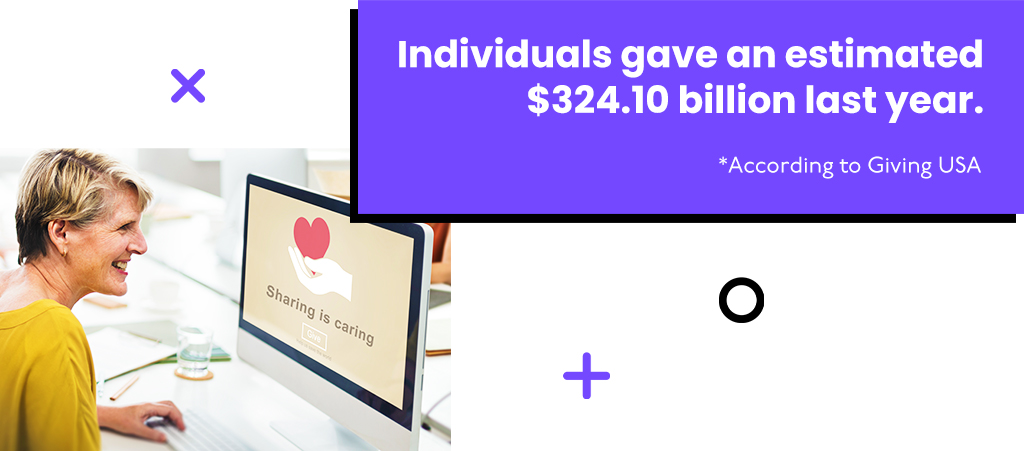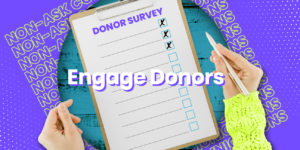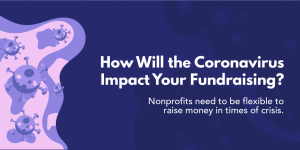We’ve said it before, and we’ll say it again – the fundraising landscape is always evolving. And this has never been truer than it is today! If you’re like other fundraisers, you’re probably looking for ways to identify trends and stay ahead of the game.
As nonprofit professionals, we use data to shape our strategies.
And you’re not alone if your nonprofit doesn’t have a robust data base to analyze your donor trends. That’s why we’ve compiled this list of 10 shocking fundraising statistics you can use to shape your strategy!
And even if you do have a ton of donor data of your own, it’s helpful to look at the trends in our industry to get a feel for what other organizations are doing and how you can benefit from what they’ve discovered!
So, let’s dig in!

1. Individual giving is up.
According to Giving USA, individuals gave an estimated $324.10 billion last year, a 2.2 percent increase over the prior year. Adjusted for inflation, individual giving achieved the highest total dollar amount to date in 2020, but comprised less than 70 percent of total giving for only the second time on record.
So, if you found yourself thinking, “maybe this isn’t the best time to ask” for any reason, put your concerns to bed!
Donors are ready and willing to support your nonprofit and help you make the world a better place!
2. Donors are giving more online.
Total online revenue grew by 32 percent last year, according to M+R Benchmarks. This increase is far greater than a typical year.
And it seems that the nonprofits that took this advice were able to raise more money online!
3. Nonprofits are doing well!
Among nonprofits surveyed by Blackbaud, 88 percent of organizations said they felt better or the same about their nonprofit’s health since the beginning of the COVID-19 pandemic.
There was a lot of uncertainty at the beginning of the pandemic, and many were worried if their donors would still be willing to give during these challenging times. It appears these concerns were mostly unfounded.

4. Nonprofits are gaining new donors.
According to the same Blackbaud survey, 45 percent of organizations reported an increase in the number of new donors.
Many individuals felt the call to do their part and make an impact by giving to charity.
5. Giving to health organizations is down.
Surprisingly, Giving USA reports that giving to health-related organizations declined by 3 percent, totaling $42.12 billion last year. This includes nonprofit hospitals and organizations that focus on addressing specific diseases.
According to Giving USA, many in-person walks, runs, and other major fundraising events hosted by disease-specific health organizations saw a decline in participation and charitable revenue due to the pandemic.
6. Mobile audiences are growing.
Nonprofit mobile audiences grew by 26 percent last year, compared to a 3 percent average increase in email list size, according to M+R Benchmarks. Email list sizes increased by 3 percent in 2020, the same growth rate reported for 2019.
It will take more than optimizing your emails for mobile users if you want to make the most out of this growing channel.
And a great way to build your mobile audience is by doing more on social media!

7. Donors prefer to give on a computer.
Half of all nonprofit website visits came from users on mobile devices last year, according to Giving USA. This marked a 9 percent increase in the traffic share for mobile. However, users on desktop devices still make up the majority of donation transactions (61 percent) and online revenue (72 percent).
Someone who finds your nonprofits website while scrolling on their phone may not be ready to make a donation.
8. Nonprofits are sending more emails.
According to Giving USA, nonprofits sent an average of 59 email messages per subscriber last year. This marks a 17 percent increase in volume from 2019.
Of these, 23 were fundraising messages, 9 were advocacy messages, 12 were newsletters, and 15 were “other,” which can include cultivation messages, event invitations, polls and surveys, or anything else.
Remember, if you’re having trouble keeping donors engaged, the problem may not be that you’re asking too often. You may just need to work in more messages that don’t make an ask in between appeals.
9. Nonprofits need to listen better.
Only one in four organizations surveyed by Blackbaud use surveys, focus groups, or targeted listening strategies to stay in tune with their donors.
The takeaway? Go straight to the source and get feedback from your donors!
10. Nonprofits are disconnected.
According to the same Blackbaud survey, 60 percent of organizations rated themselves as “excellent” at meeting donor expectations for staying true to their mission, values, and goals. However, only 44 percent of donors said the same about the nonprofits they support!
Don’t assume you know what your donors want! As always, it’s important to use direct feedback and data from your donors to guide your strategy.
And remember, if you find yourself wishing you had more data to work with, take these 10 fundraising statistics and start using them to guide your decision making going forward!








